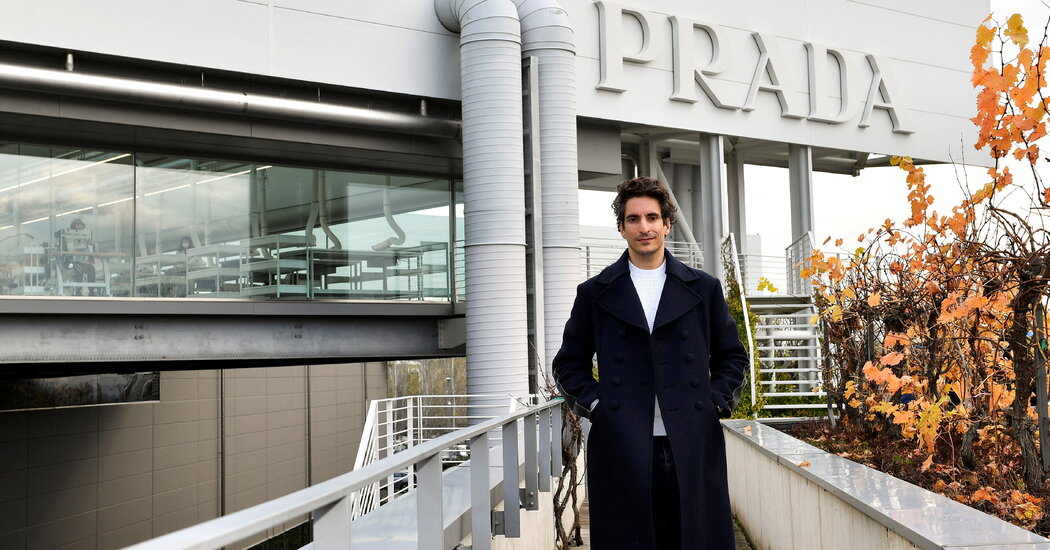In the fashion universe, Prada is known as the kind of oracle that can set the tone of an entire fashion season. So with its October debut in the field of fine jewelry — a 48-piece collection crafted entirely of certified recycled gold and ethically sourced pavé diamonds — the Milan-based brand hopes to herald more responsible approaches to jewelry and fashion among other houses.
“We couldn’t just jump in and do a line of jewelry like other brands — we had to think about how we could be disruptive,” Lorenzo Bertelli, Prada’s head of corporate social responsibility, said in a video interview. He is the elder son of Miuccia Prada and Patrizio Bertelli, co-chief executives of the brand.
It took Prada three years to secure a supply chain with green credentials, Lorenzo Bertelli explained, adding, “My mother, who’s famously passionate about jewels and a big collector, said, ‘Finally I can have fun with jewelry!’” (Prada has long sold silver and fashion jewelry collections, but they have been more elementary explorations of metal logo-embossed goods.)
Timothy Iwata, Prada’s jewelry director who joined the brand last year from Cartier, said the moment was ripe to change the jewelry sector “with sustainable practices, focusing on two key materials” — recycled gold and ethically sourced pavé diamonds — “that would send a strong signal to the industry.”
Prada also flouted luxury’s tradition of refusing to disclose suppliers, identifying collaborators like the Parisian diamond dealer Rubel & Ménasché and the gold supplier Italpreziosi of Arezzo, Italy. “Exclusivity,” Mr. Bertelli said, “makes no sense with sustainability.”
The collection uses recycled gold, salvaged from electronic parts and old jewelry, that was certified by the Responsible Jewelry Council’s Chain of Custody standards, as well as pavé diamonds mined and finished following the guidelines of the council’s environmental and humanitarian Code of Practices — a first for a global luxury brand, according to the house. The brand said that all its suppliers had been subject to multiple audits by Prada and the council’s third-party inspectors to ensure adherence to the council’s policies, which combined internationally agreed practices from sources that included the Organization for Economic Cooperation and Development, the United Nations and International Labour Organization conventions.
According to the World Diamond Council, the small diamonds used for pavé constitute 80 percent of the diamond trade’s sale quantities, “but no one was tracing pavé,” Mr. Iwata said. In contrast, many large diamonds are engraved with ID numbers to guarantee their conflict-free origins.
While some jewelry companies — including Pandora, the world’s largest jewelry company by volume — have moved to lab-grown diamonds, Prada stated it rejected them because of the vast amounts of nonrenewable energy the brand said it found was needed for manufacturing. However, Mr. Iwata noted that the brand’s research is continuing as the few colored stones used in its collection were not entirely traceable, and its next project is likely to be a high jewelry collection.
Each piece of Prada’s jewelry is being packaged with a chip-embedded warranty card attesting to its material and manufacturing origins through the Aura Consortium blockchain, introduced last year by the retail rivals LVMH Moët Hennessy Louis Vuitton, Richemont and Prada.
“There’s a lot of competition between fashion brands,” Mr. Bertelli said. “But the scope of blockchain is to create a more transparent environment for luxury.” And in the future, industry experts have said, the merits of a product’s supply chain is likely to become a fundamental part of a consumer’s deliberation about what to buy as the information becomes more accessible through digital IDs.
“We all know that luxury brands are not just selling products,” Mr. Iwata said. “We’re selling a culture, and we have cultural influence.”
The collection, named Eternal Gold, was conceived by Mrs. Prada and her fellow creative director, Raf Simons, and it references, as Mr. Iwata pointed out, their fashion approach of nods and winks to archetypes, with jewelry motifs like snakes and hearts rendered in 18-karat gold and embossed with the Prada logo.
A serpentine multicoil bracelet for the upper arm, inspired by Mrs. Prada’s tendency to throw an armband over a sweater sleeve, was fabricated with flexible hidden hinges in the style of high jewelry. Priced at $75,000, it is one of the collection’s 10 custom-order designs, which also includes a pendant of a heart puffed to the size of an apple.
Crafted by workshops in Turin and nearby Valenza, Italy’s goldsmithing capital, the jewelry uses lavish amounts of gold, unlike recent trends for slender chains and tiny earrings. “I don’t want to be blunt,” Mr. Iwata said, “but Mrs. Prada doesn’t care about those kinds of conventions.”
The collection is available in Prada’s flagship stores worldwide, but a portion of the online stock had sold out by early November. “We can’t keep up with the demand for the moment,” Mr. Iwata said.
Mr. Bertelli’s first sustainability project for Prada was to convert its signature line of nylon clothes and accessories entirely to recycled material, and in 2021 he met the goal, with the brand producing more than 100 million yards a year of its Re-Nylon fabric from post-consumer plastic and waste. Other advances, like gains in reducing carbon emissions in its operations and supply chain, are more incremental and harder to communicate, he said.
But the jewelry line, Mr. Bertelli said, clearly “sends the signal to the customer that we need to challenge industries that are opaque.”
Sumber: www.nytimes.com
